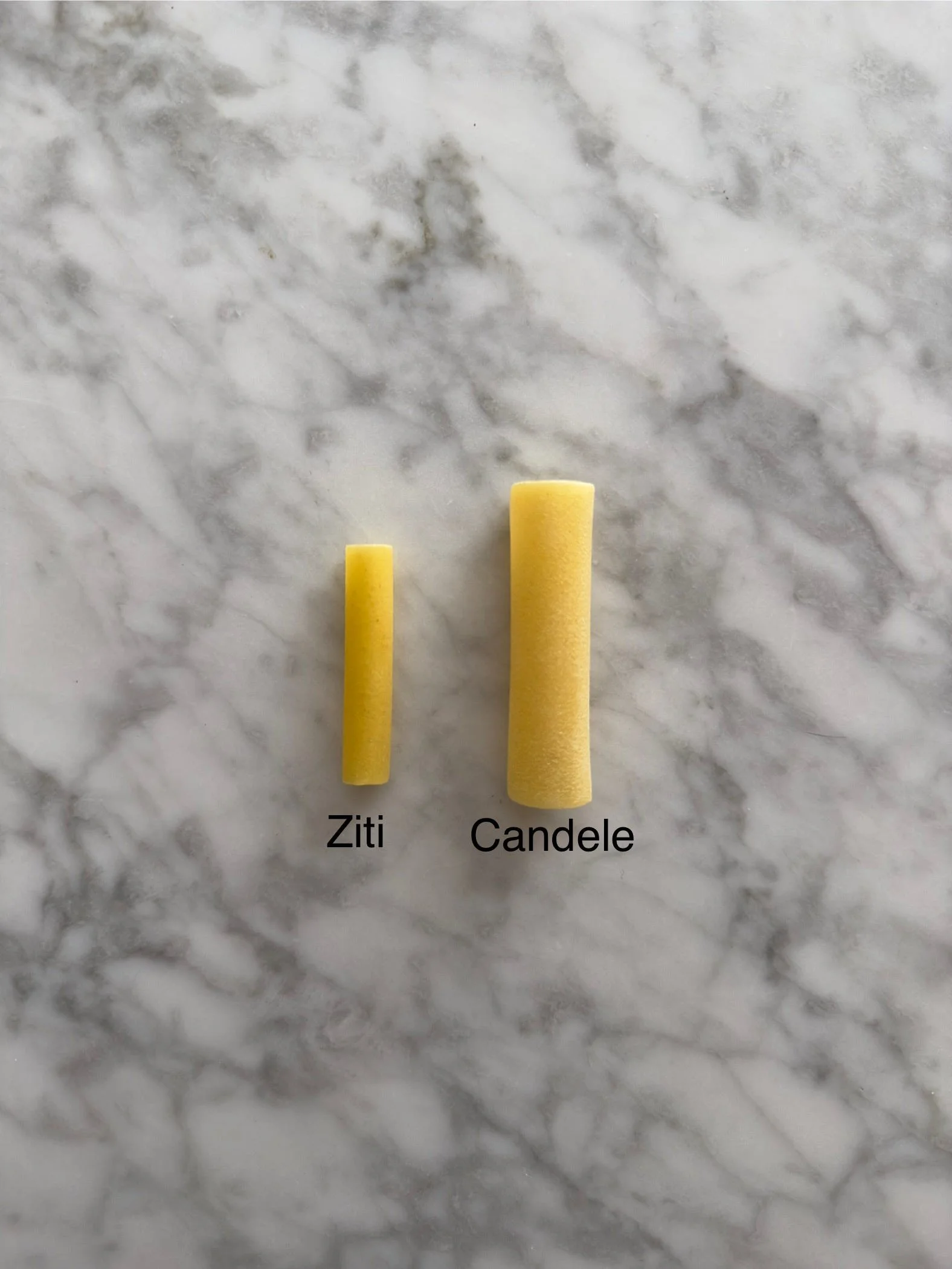Eggplant parm sauce
Today we are making comfort food! This absolute hug in a bowl is a take on the classic eggplant parmigiana but in pasta form. It’s tomato-y, it’s cheesy, it’s got notes of fresh basil and gorgeous eggplant that practically melts into the sauce - it’s a delight, the best thing since sliced bread, something you need to make immediately (humble??? I don’t know her).
You’d probably be unsurprised to know that collecting dried pasta is a bit of an obsession of mine. I have >30 different shapes and varieties in my pantry at any given time, and I simply can’t help myself but add to my collection if I come across a hard to find or fun shape. I shipped myself over 6kg of pasta back from Europe last month because I couldn’t fit it in my suitcase, which makes the shape I’m about to introduce you to very, very expensive/kg.
Candele! Which translates literally to “candles”. This shape has been on my wishlist for a couple of years but I hadn’t had any luck finding it until I was in Bologna. Candele have a plethora of monikers (cannacce, foratini, maccheroncelli, mezzani, ziti, to name a few), however it’s noted in the Encyclopedia of Pasta (by Oretta Zanini De Vita - an essential resource for any pasta nerd) that while this shape is nowadays considered synonymous with ziti, they are in fact slightly thinner than candele. To put this claim to the test, I also happened to also bring back some ziti tagliati (the short, pre-cut version) from Italy, so for the jury’s consideration I enclose a comparative photo below.
Exhibit A
Ziti is considerably smaller than Candele in both length and width.
When people talk about pasta they consistently talk about texture, ridges and crevices in relation to their sauce-catching ability. Sure, I do this too! Sauce-catching often = superiority in the pasta world. Or so I once thought. In more recent years I have been leaning heavily into lisce varities, vibing their smooth mouth-feel and lip-smacking quality that rigatoni could never. I infamously (can I declare that?) said that penne lisce was my least favourite short pasta, and now I’m not so sure that remains true.
Eggplant parm or pasta alla Siciliana? You’re most likely familiar with parmigiana di melanzane (eggplant parmigiana), and you’re also likely familiar with pasta alla norma (eggplant in tomato sauce), both of which are delicious Sicilian dishes. This sauce brings the two together - a norma-esque base sauce with the addition of melty mozzarella and sharp parmigiano to bring in the immaculate vibes of eggplant parm. I have also come across this as pasta alla Siciliana made with a mix of caciocavallo and scamorza (this recipe from Giorgia’s Bakery was a big source of inspo for this recipe), but when deep diving into pasta alla Siciliana in general, the results were somewhat inconclusive. It seems that in some cases, pasta alla Siciliana is like an eggplant parm sauce, with claims of an Italo-American heritage, while elsewhere pasta alla Siciliana can range from alla norma, to something entirely different (a spaghetti dish hailing from Messina, rich in flavour from capers, sun dried tomatoes, sultanas, olives and anchovy!). Additionally a similar sauce is claimed as pasta alla Sorrentina, again using scamorza as cheese of choice and tying its origins to mainland Italy. Etymology aside, one thing I noticed is that more often than not, the pasta of choice was a smooth, lisce-type tube - usually paccheri (origin of the word can be linked to the onomatopoeic Neapolitan paccaria which means “to slap” - perfectly descriptive of how it eats), and with a smooth and melty sauce like this one I think this aspect is essential to the enjoyment of the dish. The sauce glides over the pasta as opposed to getting held up on any ridges, but the hollows of the tube still capture the goods as desired.
You must make this!
Eggplant Parm Sauce
Serves 4
Ingredients
360g candele, or pasta of choice. But I want you to choose a smooth one, ok?
1 medium eggplant
1 tbsp salt
Enough neutral oil for shallow frying the eggplant
3 tbsp extra virgin olive oil
2 garlic cloves, slightly smashed but left whole
500g good quality passata di pomodoro
1/2 tsp sugar (if needed)
A handful of fresh basil leaves
30g parmigiano reggiano, finely grated
150g low-hydration mozzarella (the harder one that doesn’t come in a tub of liquid), cut into small cubes
Method
Start by thinly slicing the eggplant - 1-2cm thickness would be ideal. Lay the slices out on a baking sheet and sprinkle with the salt, then leave for about 15-20 minutes.
Thoroughly rinse the eggplant under water, then pat dry as best as you can with paper towel.
Add enough of the neutral oil to a pan for frying the eggplant, and fry in batches until lightly golden before placing on paper towel. Set aside until ready to use.
To make the sauce, heat 2-3 tablespoons of olive oil in a large pan / sauteuse and add the garlic cloves.
Once fragrant, add the passata and stir to combine with the olive oil. Let this simmer gently while you cook the pasta. Taste the sauce over time, season to taste with salt, and if the tomatoes are proving to be a little tart, add the sugar - otherwise you can omit.
Bring a large pot of water to a rolling boil and salt well - cook the candele according to packet instructions, until just al dente.
Back to the sauce (still simmering over a low heat), discard the garlic cloves (if desired), throw in the fresh basil, cooked eggplant and add the al dente pasta before scattering both cheeses over the top.
Allow the cheese to melt, tossing and agitating the pan to help it along.
Serve immediately while the cheese is still melty! With a drizzle of extra virgin olive oil because, of course.




